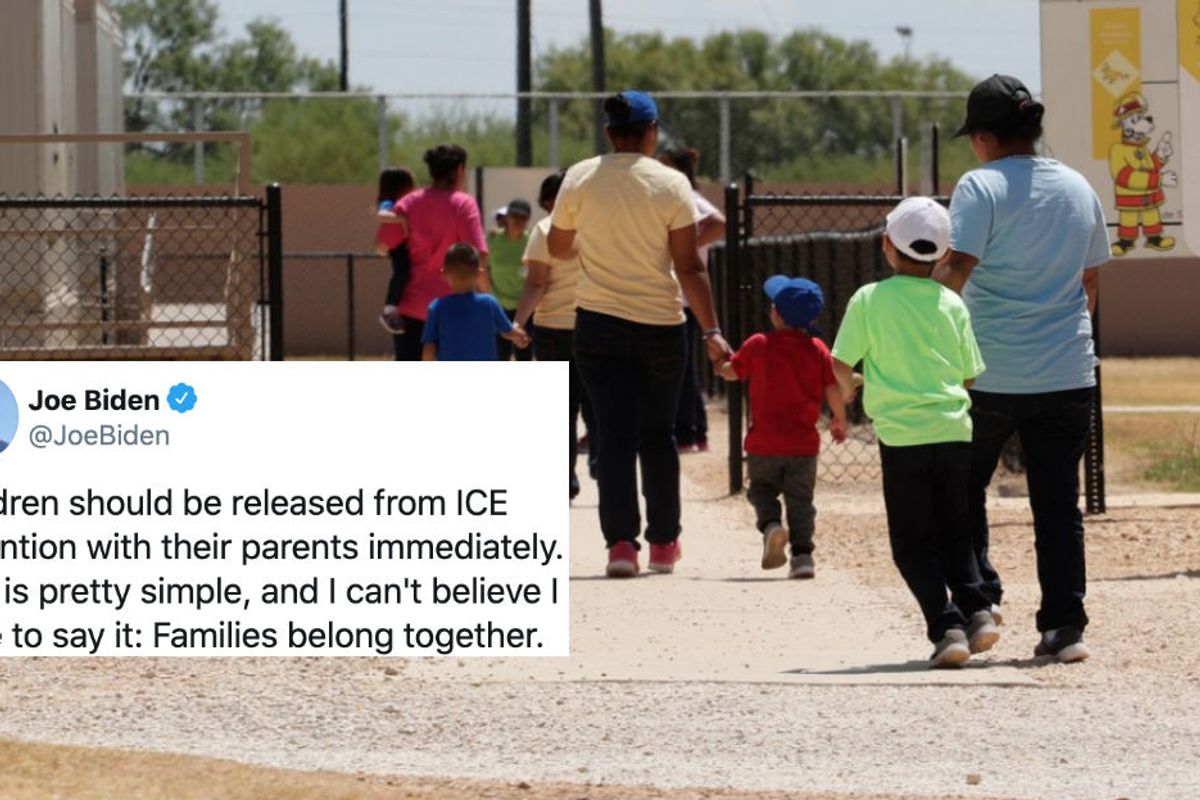Judge orders all detained immigrant children released. But only because COVID-19 is 'on fire' in detention centers.

As a result of declining health conditions within ICE Family Retention Centers, a U.S. District Judge from California has ordered the release of all detained immigrant children by July 17. While this is presented as a victory on a humanitarian level, it still leaves a copious amount of questions. Why can't all families be released while the coronavirus is running rampant? Why are kids the only concern? How long do kids have to wait to see their families again? Will they ever see them? If no one in the U.S. will sponsor the kids or they don't have a relative on site, will they be placed in better conditions?
Children are locked in cells and cages nearly all day long. Yazmin Juárez, a Guatemalan woman, watched her 19-month-old daughter Mariee die of a viral lung infection from neglect and mistreatment after being held in an ICE facility in 2018. She told a congressional panel that she begged for medical staff for help. She watched as her daughter got more and more sick, while doctors and nurses barely treated her. "We made this journey because we feared for our lives," she said in Spanish at the hearing, with a photograph of her and her daughter next to her. "I hoped to build a better, safer life for my daughter. Unfortunately, I watched my baby girl die, slowly and painfully."
This shouldn't be happening. Why are the detention centers in such poor conditions? Babies should not be dying. Families shouldn't have to lose their loves ones. Although children being released may seem like a victory right now, it's a very small one, as there is still an overall systemic health and human rights problem at these detentions centers continually plaguing the United States.
Upon hearing reports from federal court monitors, Judge Dolly Gee referred to the ICE-operated facilities as being "on fire." According to NPR, Gee wrote, "Although progress has been made, the Court is not surprised that [COVID-19] has arrived at both the [Family Residential Centers] and [Office of Refugee Resettlement] facilities, as health professionals have warned all along."
ICE has been reluctant to release children being held in retention centers. "In order for [ICE] to do it in a humane way, they have to release the child with the parent," says attorney Holly Cooper, co-director of the University of California and Davis Immigration Law Clinic. She tells NPR, "What we're hoping is that ICE will do the humane thing and not separate any child from their parents because that's what the children want. That's what the advocates want. That's what the parents want."
Gee's orders can be carried out in two ways: one is that minors can be released to suitable sponsors provided there is signed consent from their parents or guardians. Secondly, minors can be released along with their parents or guardians in the event ICE, or a court document, determines that the conditions at their current facility justifies a transfer to a non-congregate setting.
The real problem lies with our definition of "humane." These families risked everything to come to this country for a better life. It is easy to say they broke the law because they didn't go through the appropriate channels, but not everyone is educated on American law.
These families risk so much to start another life in America. Let's be honest, it's probably not the best environment where they are escaping from. But these detention centers may even be worse. President Trump kicked off his 2015 campaign calling immigrants from Mexico "rapists" and "killers." Our country can do better.
Perhaps some may have unsavory intentions, but last time I checked, so do American citizens. So, put yourself in their shoes. Unless your children have a safe place to go with a relative or close friend, would you really let them go to a foreign building where you cannot protect them?
Ask yourself, is this really a victory for humanity? What would wealthy and privileged Americas do if faced with this issue? Our government can do more.
- Illegal immigration myth buster: A lawyer sets the record straight on ... ›
- Next Time Someone Tells You That Immigrants Are Destroying Our ... ›
- 15 companies that took bold stands against Trump's immigration ban. ›
- Judge offers alternative sentences to young offenders like 'get your grades up' and 'vote' - Upworthy ›
- Kidnapping survivor Amanda Berry has teamed up with U.S. Marshals to find over 50 missing children ›



 Meatloaf was a staple dinner.
Meatloaf was a staple dinner. Spaghetti is still a classic.
Spaghetti is still a classic. Why were pork chops so popular?
Why were pork chops so popular?
 First Lady Jacqueline Kennedy greets guests before a reception for the Wives of American Society of Newspaper Editors Members.via
First Lady Jacqueline Kennedy greets guests before a reception for the Wives of American Society of Newspaper Editors Members.via  A gorilla walking on its knuckles. via
A gorilla walking on its knuckles. via 

 Cooking at home is almost always cheaper than eating out, and often significantly so.
Cooking at home is almost always cheaper than eating out, and often significantly so. Bulk spices often cost a fraction of what they cost in jars.
Bulk spices often cost a fraction of what they cost in jars. Growing your own food can save you money.
Growing your own food can save you money. Biking is free.
Biking is free. Public libraries are treasure troves of free items to borrow.
Public libraries are treasure troves of free items to borrow.
 A person in gloves inspecting for bed bugs.
A person in gloves inspecting for bed bugs.